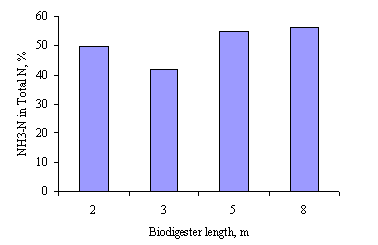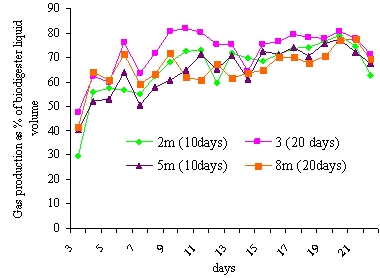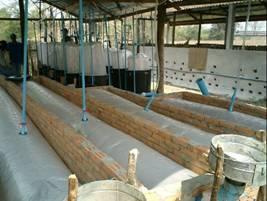- Salud animal
- Nutrición animal
- Genético y biodiversidad
- Medio ambiente y recursos naturales
- Socio-economía en sector del cerdo
- Calidad y seguridad del alimento
- Cría y prácticas sostenibles
- Desarrollo rural
length: diameter ratio in polyethylene biodigesters | Effect of length: diameter ratio in polyethylene biodigesters on gas production and effluent composition
Do lengths of biodigesters influence gas production and retention time? (from Livestock Research for Rural Development)
Abstract
Introduction
Many factors influence gas production and the fertilizer value of the effluent in tubular plug-flow biodigesters. Studies have been made on the effect of retention time, temperature, types of manure and concentration of solids in the influent (Boodoo et al 1979; Bui Xuan An and Preston 1999; San Thy et al 2003). However, the configuration of tubular polyethylene biodigesters, namely the ratio of diameter to length has not been studied. Most biodigesters of this type have been between 8 and 10m in length with a diameter of 1 m (Duong Nguyen Khang personal communication), equivalent to a ratio of 10.1:1 and 12.7:1 between length and cross-sectional diameter. Smaller biodigesters (2m long by 0.63m diameter; ratio of 6.4:1 of length to cross-sectional area)) were used by San Thy et al (2003) and appeared to be very efficient with production rates exceeding 100% of the biodigester liquid volume. It was therefore hypothesized that different ratios of length to cross-sectional area in tubular polyethylene might influence the rate and efficiency of gas production.
Hypotheses
The hypothesis was that a length: ratio of 5: 1 (length: area ratio of 6.3:1) of of the biodigester would result in higher rate of gas production and more efficient use of substrate than narrower or wider ratios; and that a retention time of 10 days would give higher gas production than 20 days.
Materials and methods
Location
The experiment was conducted in the four countries participating in the MEKARN project (http://www.mekarn.org) : Cambodia (CelAgrid, Cambodia), Thailand (Chiang Mai University), Vietnam (Nong Lam University) and Lao (Livestock Research Centre). The activities in the different countries were initiated at different times: in Vietnam from September to November 2003, in Cambodia and Lao from February to April 2004; and Thailand from June to July 2004.
Experimental treatments and design
The treatments arranged as a 4*2 factorial were: Length: diameter ratio and hydraulic retention times. Each location was considered as a replicate.
Length: diameter ratios
These were as follows (length: cross-sectional area is in brackets):
Retention time
This was 10 or 20 days.
The design was a single changeover with experimental periods of 40 days on each retention time (Table 1).

In each location, four experimental biodigesters were constructed according to the design developed by San Thy et al (2003). Tubular polyethylene film of 63 cm diameter was used to construct 4 biodigesters in each locaton(2, 3, 5 and 8m length).
Inoculation
At the beginning, the biodigesters were inoculated with effluent from a functioning biodigester. The ratios used were 60% of digester effluent and 40 % of water. A mixture of manure and water was added to give an initial solids concentration of 4% (Table 2). At the time of changeover, water was added at 50 % of biodigester liquid volume to facilitate the outflow of organic solid materials from the first period that might effect biogas yield in the next period.

Construction of biodigesters
The 16 plug-flow biodigesters (in each location there were 4 biodigesters) were made from tubular polyethylene film (internal diameter 0.63m), mounted in shallow trenches lined with bricks (to ensure the dimensions were exactly the same size of plastic biodigester), to provide a liquid volume in the proportion of 80% of the total biodigester capacity (Photo 1). The biodigesters were installed in an area with the same microclimate condition by shading them with corrugated iron roof at 3 m above the ground. During the subsequent adaptation and data collection periods, the fresh pig manure and water were added in the proportion indicated for each loading rate treatment (Table 3).
Manure
Pig manure was used in each location. The loading rate was 4 kg DM per m³ of liquid volume. The manure was collected daily in the early morning from the pig pen and stored in a polyethylene sack. The pigs were fed a mixed feed formulated according to each location (Vietnam and Thailand fed by commercial feed and Lao and Cambodia fed by formulation feed, or high fiber feed such as water spinach, cassava silage, distillery waste and brewery spentd grain mixed with commercial feed).
The biodigesters were charged daily at exactly the same time and with the amounts of fresh manure and water according to the treatments and the liquid volume of the biodigester (Table 3). The indicated amount of pig manure was fixed on a DM basis. The amount of water added was determined by retention time (Table 3).

Data collection and analyses
The experimental data were recorded daily during the last 20 days of each experimental period. Samples of fresh pig manure and effluent were taken daily on days 21 to 40, immediately before (manure) and after (effluent) charging the biodigester.
The samples of fresh manure were bulked and mixed every 10 days, and effluent every 7 days, prior to taking representative samples for analysis of total N and ammonia-N using a Foss-Tecator Kjeldahl apparatus and for organic matter by ashing the samples in a furnace oven (AOAC 1990). DM content was determined by microwave radiation (Undersander et al 1993).
Gas production was measured daily using the system of water displacement developed by San Thy et al (2003) (Photo 2). The change in volume was recorded 2 to 3 times a day to determine daily gas production.
Statistical analyses
The data were subjected to analysis of variance (ANOVA) using the General Linear Model (GLM) of the MINITAB software Release 13.31 (2000). The model was:
Yij k = µ + Ti +Pj + Ak+ eijk
Where:
Results and discussion
Manure at different locations
There were no differences in the DM, OM and total N concentration of the manure between locations (Table 4). Ammonia-N as a proportion of total N was highest in he pig manure in Lao and Vietnam and lowest in Cambodia and Thailand.

Influent
Ammonia-N as percentage of total N was higher for the more diluted influent (10 day retention time (Table 5).

OM content of the DM of the manure was lower in Lao and Cambodia than in Thailand and Vietnam (Table 6). Correspondingly, NH3-N as proportion of total N was higher in Cambodia and Lao.

Ammonia-N as proportion of total N was higher in the influent than in manure , presumably reflecting microbial action between the time taken to sample raw manure, and the adding of water and stirring activities to make the influent slurry (Figure 1).

Biodigester effluent
There was no effect of the length of the biodigester on the DM, OM, total N and ammonia N (total ammonia as well as percent of total N) in the effluent (Table 7).

There was no effect of the manure dilution rate (retention time) on the proportion of total N in effluent in the form of ammonia (Table 8), nor of the biodigester length (Figure 2).

San Thy et al (2003), using pig manure with different loading rates of 2.93, 1.46 and 0.92 kg DM/day/m3 liquid volume and hydraulic retention times of 10, 20, and 30 days, observed that the proportion of ammonia N to total N increased with longer retention time but when pig manure loading rate was fixed, it was not affected by retention time.
These experimental data do not support the original hypothesis that shorter biodigesters and retention time would support a greater degree of conversion of organic-N in the influent to ammonia-N in the effluent. However, the substantial improvement in ammonia-N as proportion of total N in the transition from manure to influent (diluted manure) from 9.54-15.03% to 20.7-31.% to 41.8-56.1%) is in accordance with the findings of Pedroza et al (2001) who reported increases from 20 in the influent to 60 in the effluent and San Thy et al (2003) who reported increases from 20 to 50-60 % of ammonia-N in total N in influent and effluent.

Biogas production
Adaptation period
After inoculation of the biodigester and an adaptation period of about 8 days, the biodigesters were charged daily with manure and water according to treatment. The trend in rate of gas production during this phase (Figure 3) was similar to that reported by San Thy et al (2003).


Gas production (during collection period)
There were no differences between biodigester dimensions for gas production as litres per kg DM (and OM) of manure, or as proportion biodigester liquid volume (Table 9).

Gas production in different countries
The biogas production differed among the countries with highest values for Cambodia, followed by Lao, Vietnam and Thailand (Table10). We have no obvious explanation for these differences.

All measures of gas production showed increases for the longer retention time of 20 days (Table 11). This is in agreement with data in the literature (Figure 5) which showed a peak in production at around 20 day retention times and then a decline.


Conclusions
Acknowledgement
The authors would like to thank the Swedish Agency for Research Cooperation with Developing Countries (SAREC) for funding this study through the regional MEKARN project, and all friends and research teams in riparian countries for their cooperation during the experiment.
References
- AOAC 1990 Official Methods of Analysis. Association of Official Analytical Chemists. 15th edition (K elrick editor) Arlington pp 1230
- Boodoo A, Delaitre C and Preston T R 1979 Effect of retention time on biogas production from slurry produced by cattle fed sugar cane. Tropical Animal Production 4:21
- Bui Xuan An and Preston T R 1995 Low-cost polyethylene tube biodigesters on small-scale farms in Vietnam. Electronic Proceedings, Second Int. Conf. on Increasing Animal Production with Local Resources, p.11. Zhanjiang, China
- Bui Xuan An and Preston T R 1999 Gas production from pig manure fed at different loading rates to polyethylene tubular biodigesters. Livestock Research for Rural Development (11) 1: http://www.cipav.org.co/lrrd/lrrd10/3/an111.htm
- Bui Xuan An, Preston T R and Dolberg F 1997 The introduction of low-cost polyethylene tube biodigesters on small scale farms in Vietnam, Livestock Research for Rural Development, 9:2 http://www.cipav.org.co/lrrd/lrrd9/2/an92.htm
- Duong Nguyen Khang, Le Minh Tuan and Preston T R 2002 The effect of fibre level in feedstock, loading rate and retention time on the rate of biogas production in plug-flow and liquid displacement biodigesters. Proceeding biodigester workshop March 2002. http://www.mekarn.org/procbiod/khang.htm
- Hamilton D W, Sharp P R and Smith R J 1984 The Operation Characteristics of a manure digester for 60 beef cattle. Agriculture Engineering Department, Iowa state University, Ames. Journal paper No. J-11879 of the Iowa Agriculture and Home economic experimental station.
- Hayes T D, Jewell W J, Dell, Orto S, Fanfoni K J, Leuschner A P and Sherridan D R 1979 Anaerobic digestion. Appl. Sc. London, UK
- Lotte C, Lassen M and Nielsen K H 1996 Evaluation of Small Scale Biogas digesters in Turiani, Nronga andAmani, Tanzania http://www.ihh.kvl.dk/hml/php/tune96/16Knielsen.htm.
- Polprasert C, Edwards P, Rajput V S and Pacharaprakiti C 1985 Integrated Biogas Technology in the Tropics Performance of Small Scale Digesters, Waste management and Research 1986. Asian Institute Technology Thailand
- Polprasert C, Edwards P, Rajput V S and Pacharaprakiti C 1982a Recycling rural and urban night soil in Thailand. Asian of Institute Technology research report no 143.
- Safley L M, Vetter R L and Smith L D 1987 Management and Operation of a full scale poultry waste digester. Poultry Science 66:941-945
- San Thy and Preston T R 2003 Effluent from biodigesters with different retention times for primary production and feed of Tilapia (Oreochromis niloticus). MSc Thesis, MEKARN-SLU
- San Thy, Preston T R and Ly J 2003: Effect of retention time on gas production and fertilizer value of biodigester effluent. Livestock Research for Rural Development 15 (7). Retrieved , from http://www.cipav.org.co/lrrd/lrrd15/7/sant157.htm
- San Thy, T R Preston and J Ly 2003 Effect of retention time on gas production and fertilizer value of biodigester effluent, Livestock Research for Rural Development 15 (7) 2003, http//:www.cipav.org.co/Irrd/Irrd15/7/cont157.htm
- Soeurn Than 1994. Low cost biodigesters in Cambodia. Proc. National Seminar-workshop in sustainable Livestock Prod. on local feed resources. Agric. Pub. House Ho Chi Minh, pp.109-112.
- Undersander D, Mertens D R and Thiex N 1993 Forage analysis procedures. National Forage Testing Association. Omaha pp:154.
Citation of this paper
Comentarios
CIRAD © 2007 (Derechos reservados) - Legales informaciones - Actualizaión de la pagina : 02/05/2007
